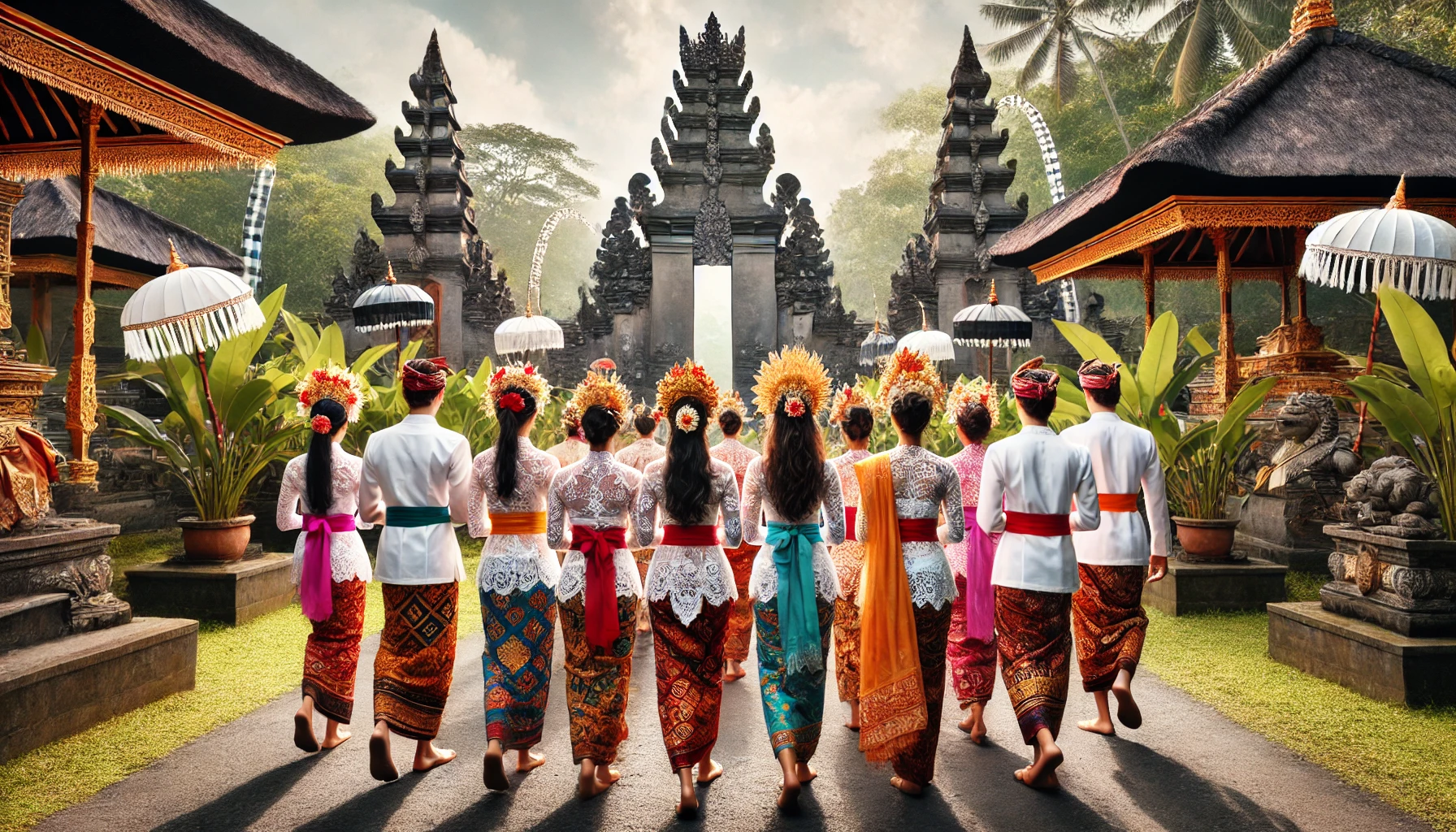
Balinese culture is renowned for its deep spirituality, intricate rituals, and captivating artistic expressions. Among these cultural practices, the tradition of wearing specific temple attire when visiting sacred places stands out as a significant expression of reverence and respect. The Balinese temple dress is not just a matter of tradition but a symbol of cultural identity and devotion. This attire, worn during temple visits, religious ceremonies, and festivals, carries profound meaning in terms of symbolism, spirituality, and social decorum. This article explores the various aspects of Balinese temple dress, from its components to its cultural importance and the rules governing its use.
The Components of Balinese Temple Dress: Tradition in Detail
Balinese temple attire is composed of several distinct pieces, each carrying its own meaning and function. For both men and women, the outfit generally includes a combination of cloth wraps, sashes, and head coverings, all tied together with a sense of grace and balance.
For men, the primary components include the “kamen”, a sarong-like wrap that covers the lower half of the body. The kamen is often made of traditional batik or other decorative fabric, and the length and style of the wrapping may vary depending on the occasion. The “saput”, a secondary wrap worn over the kamen, adds an extra layer of decorum, often featuring ornate patterns or bright colors. Men also wear a “udeng”, a folded headband, symbolizing purity and focus during prayer.
For women, the temple dress starts with the kamen as well, but they also wear a “kebaya”, a lace blouse that beautifully complements the sarong. A “selendang”, or sash, is tied around the waist or draped over the shoulder to add elegance and signify discipline. Both men and women, when properly dressed for temple, present an image of harmony with their surroundings, reflecting the essence of balance in Balinese culture.
Wearing temple dress is not just a matter of following rules; it is about becoming part of the sacred atmosphere. The attire connects individuals with the divine, allowing them to participate in the rituals with the right mindset and humility.
The Cultural Significance of Temple Dress in Balinese Society
The importance of proper temple dress in Bali goes beyond mere aesthetics. The clothing worn during religious ceremonies represents an individual’s connection to their community, ancestors, and the spiritual world. Dressing appropriately in a temple signals a deep respect for tradition and the sacredness of the place.
In Balinese Hinduism, the act of dressing up for temple worship is an essential aspect of “Tri Hita Karana,” the philosophical foundation of Balinese life, which emphasizes harmony between humans, nature, and the divine. By adhering to temple dress codes, individuals show their respect for the deities, their fellow worshippers, and the environment. This cultural practice also reflects the Balinese value of “Taksu”—the divine inspiration and spiritual energy that comes from living in harmony with the world.
Temples are not just places of prayer but are also community centers where people come together to celebrate important life events, from births and weddings to temple anniversaries. The temple dress helps unify individuals, bringing a sense of equality and shared purpose. It removes social barriers, as everyone, regardless of their social status, is required to dress modestly and respectfully when entering sacred spaces.
The vibrant patterns, colors, and fabrics of the temple attire also communicate a connection to nature. Many traditional motifs reflect the beauty of the Balinese landscape, such as flowers, leaves, and waves, symbolizing a reverence for the natural world that is deeply ingrained in Balinese spirituality.
Rules and Etiquette: Wearing Balinese Temple Dress Correctly
While Balinese temple attire is beautiful and rich in cultural symbolism, wearing it correctly is an important aspect of showing respect. There are specific guidelines to follow when visiting a temple, and failing to do so may be seen as disrespectful.
The first and most important rule is modesty. Both men and women must cover their bodies appropriately. For men, this means wearing a kamen that reaches below the knees, while women should wear sarongs or skirts that cover the legs fully. Additionally, the use of transparent or tight-fitting clothing is discouraged, as it does not align with the principles of modesty in sacred spaces.
A sash or belt, known as a selendang, is mandatory for both genders. The purpose of this accessory is to symbolize the individual’s control over their lower instincts and desires. The sash is tied around the waist, acting as a reminder of the spiritual discipline one must maintain during the temple visit.
Head coverings are another essential part of the temple dress code. Men are required to wear an udeng, while women generally do not cover their heads unless it is for a special occasion. The udeng signifies purity and helps the wearer focus on their prayers and offerings. In contrast, women’s hair should be tied back neatly, further emphasizing the importance of cleanliness and focus during religious activities.
Before entering a temple, it’s also important to ensure that the attire is clean and in good condition. Wearing dirty or torn clothes is considered highly disrespectful to the sacred space and the gods. Moreover, those who are menstruating are generally prohibited from entering temple grounds, reflecting ancient beliefs about ritual purity.
The Role of Colors and Fabrics in Temple Dress
In Bali, colors and fabrics are not chosen arbitrarily, especially when it comes to temple dress. Every color and material carries symbolic weight and contributes to the spiritual atmosphere during religious ceremonies.
White is the most prominent color seen in temple attire, symbolizing purity, goodness, and holiness. It is commonly worn during large temple ceremonies such as Galungan and Kuningan, major festivals that celebrate the victory of good over evil. White clothing reflects the individual’s desire to purify themselves and approach the gods with a clear heart.
Yellow is another common color, often used in sashes or headgear. This color is associated with wisdom and prosperity, and it plays a significant role in offerings and ceremonial decorations. Yellow represents the earthly powers of the gods and their benevolent influence over human life.
Black and white checkered fabric, known as Poleng, is also commonly seen in temple dress and temple decorations. This pattern represents the balance between opposing forces, such as good and evil or life and death. Poleng cloth is often worn by temple guardians or those performing important ritual duties, symbolizing their role in maintaining cosmic balance.
The types of fabric used also carry symbolic meaning. Traditional Balinese temple dress often incorporates Batik or Songket, both of which are handwoven and feature intricate designs. Songket, a luxurious fabric woven with gold or silver threads, is typically reserved for important ceremonies or high-status individuals. These fabrics add an element of richness and grandeur to the temple atmosphere, reflecting the spiritual significance of the occasion.
The Evolving Nature of Temple Dress in Modern Bali
While the essence of Balinese temple dress remains rooted in tradition, there has been an evolution in how people approach this custom in modern times. With the growth of tourism and the increasing number of international visitors attending temple ceremonies, there has been a growing awareness about making traditional attire more accessible to outsiders.
Today, many temples in Bali offer rental services for sarongs and sashes, ensuring that tourists who wish to visit sacred sites can do so respectfully. This practice helps to preserve the sanctity of the temples while educating visitors about the importance of wearing appropriate clothing. However, local Balinese people often distinguish between the temple attire worn by locals and the more simplified versions worn by tourists. For Balinese Hindus, wearing temple dress remains a deeply personal and spiritual act, whereas for tourists, it may be more of a cultural experience.
Despite these changes, the core values of modesty, respect, and purity still dictate what is appropriate to wear in sacred spaces. Even in an increasingly modernized world, the ritual of donning temple attire before a religious ceremony or festival remains a strong symbol of Balinese cultural identity.
In recent years, there has also been a resurgence of interest in preserving traditional weaving techniques and fabrics used in temple attire. Many local artisans continue to produce batik and songket by hand, ensuring that these ancient crafts remain alive for future generations. This reflects a broader movement in Bali towards cultural preservation, where even as the island becomes more globalized, traditional practices are maintained with pride and care.
Conclusion
Balinese temple dress is more than just a set of rules for what to wear; it is a profound expression of respect, spirituality, and cultural identity. Each component of the attire, from the sarong to the sash and headgear, carries layers of meaning that connect individuals to their community, their environment, and the divine. By adhering to the principles of modesty and purity, those who wear temple dress honor the sacred spaces they enter and the rituals they perform.
Whether you are a local participating in a religious festival or a visitor exploring the rich spiritual heritage of Bali, understanding and respecting the tradition of temple dress is essential. It not only allows you to engage meaningfully with Balinese culture but also helps preserve these valuable customs for future generations. As Bali continues to evolve, the tradition of wearing temple dress remains a vital link to the island’s ancient spiritual roots, reminding all who wear it of the importance of balance, harmony, and respect.
Warm and Welcoming People
In Indonesia, one of the most cherished aspects that visitors frequently remark on is the warmth and hospitality of its people. The locals of Indonesia have a deeply rooted tradition of welcoming outsiders with open arms, a practice embedded in the culture for generations. This warm reception goes beyond just friendly smiles; it’s about genuine interest and respect, making tourists feel at home from the moment they arrive.
Whether in bustling cities or quaint rural villages, the people of Indonesia are known for going out of their way to make visitors feel comfortable. It’s common for locals to offer directions, share insights about hidden spots, or even invite travelers for a meal. This openness to strangers is not only a mark of respect but also a way to share their culture and heritage, allowing tourists to experience the authentic soul of the country.
This warmth makes a visit to Indonesia more than just a journey to a new place; it becomes a memorable experience of human connection. By the end of their stay, many travelers feel they’re leaving not just a beautiful landscape but also newfound friends. It’s this unique combination of natural beauty and heartfelt hospitality that makes Indonesia an unforgettable destination, resonating in the memories of everyone who has had the pleasure of experiencing it.









